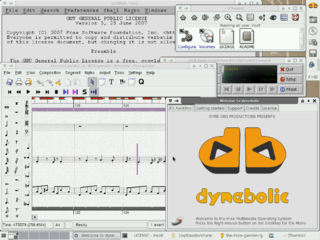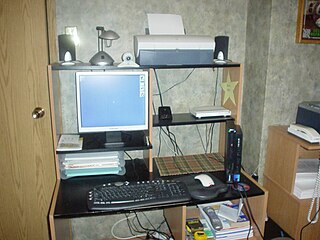The Rio Receiver was a home stereo device for playing MP3 files stored on your computer's hard drive over an Ethernet or HomePNA network. It was later rebranded and sold as the Dell Digital Audio Receiver.
MP3 is a coding format for digital audio. Originally defined as the third audio format of the MPEG-1 standard, it was retained and further extended—defining additional bit-rates and support for more audio channels—as the third audio format of the subsequent MPEG-2 standard. A third version, known as MPEG 2.5—extended to better support lower bit rates—is commonly implemented, but is not a recognized standard.

Ethernet is a family of computer networking technologies commonly used in local area networks (LAN), metropolitan area networks (MAN) and wide area networks (WAN). It was commercially introduced in 1980 and first standardized in 1983 as IEEE 802.3, and has since retained a good deal of backward compatibility and been refined to support higher bit rates and longer link distances. Over time, Ethernet has largely replaced competing wired LAN technologies such as Token Ring, FDDI and ARCNET.
The HomePNA Alliance is an incorporated non-profit industry association of companies that develops and standardizes technology for home networking over the existing coaxial cables and telephone wiring within homes, so new wires do not need to be installed.
With a design derived from the existing Linux-based Empeg Car, it became popular among the Linux hacking community.

Linux is a family of open source Unix-like operating systems based on the Linux kernel, an operating system kernel first released on September 17, 1991 by Linus Torvalds. Linux is typically packaged in a Linux distribution.
The Empeg Car is the first in-dash MP3 player developed. In 1998 a British company called Empeg was formed to build the unit, which shipped the following year.
The hardware consisted of a Cirrus Logic 7212 CPU (ARM720T at 74 MHz), 1Mx32 (4 MB) of EDO RAM, and either 512k×16 or 256k×16 (1 MB or 0.5 MB) of NOR flash used to boot. Audio output used a Burr-Brown PCM1716 DAC that drove line outputs, the headphone jack, and a Tripath class-D digital audio amplifier for speakers. Network connections were via either a Cirrus logic 8900A (10MBit Ethernet) or a Broadcom HomePNA 10 Mbit/s chipset; if no Ethernet link was seen at boot time, the unit tried HomePNA. The user interface was a 128x64 pixel monochrome LCD with an EL backlight, a rotary control with a push button, several buttons and IR remote control.
ARM, previously Advanced RISC Machine, originally Acorn RISC Machine, is a family of reduced instruction set computing (RISC) architectures for computer processors, configured for various environments. Arm Holdings develops the architecture and licenses it to other companies, who design their own products that implement one of those architectures—including systems-on-chips (SoC) and systems-on-modules (SoM) that incorporate memory, interfaces, radios, etc. It also designs cores that implement this instruction set and licenses these designs to a number of companies that incorporate those core designs into their own products.
The megabyte is a multiple of the unit byte for digital information. Its recommended unit symbol is MB. The unit prefix mega is a multiplier of 1000000 (106) in the International System of Units (SI). Therefore, one megabyte is one million bytes of information. This definition has been incorporated into the International System of Quantities.

In electronics, a digital-to-analog converter is a system that converts a digital signal into an analog signal. An analog-to-digital converter (ADC) performs the reverse function.
The unit booted via a 2.2 linux kernel in flash which used DHCP and SSDP to discover an NFS server from which it loaded a new kernel. The second kernel then mounted a root filesystem over NFS containing a small set of standard POSIX tools and an application for selecting and playing music over the network, which was served using HTTP by the Audio Receiver Manager software running on a Windows PC. Although the music player and the Audio Receiver Manager and Broadcom HomePNA kernel driver module were proprietary software, the kernel and other tools were open source. The two-step kernel boot process allowed rapid development of changes to the kernel allowing units to run new kernels by simply power cycling them; the use of standard protocols meant a variety of replacement software components could be developed independently.
The Simple Service Discovery Protocol (SSDP) is a network protocol based on the Internet protocol suite for advertisement and discovery of network services and presence information. It accomplishes this without assistance of server-based configuration mechanisms, such as Dynamic Host Configuration Protocol (DHCP) or Domain Name System (DNS), and without special static configuration of a network host. SSDP is the basis of the discovery protocol of Universal Plug and Play (UPnP) and is intended for use in residential or small office environments. It was formally described in an Internet Engineering Task Force (IETF) Internet Draft by Microsoft and Hewlett-Packard in 1999. Although the IETF proposal has since expired, SSDP was incorporated into the UPnP protocol stack, and a description of the final implementation is included in UPnP standards documents.
Network File System (NFS) is a distributed file system protocol originally developed by Sun Microsystems in 1984, allowing a user on a client computer to access files over a computer network much like local storage is accessed. NFS, like many other protocols, builds on the Open Network Computing Remote Procedure Call system. The NFS is an open standard defined in Request for Comments (RFC), allowing anyone to implement the protocol.
The Portable Operating System Interface (POSIX) is a family of standards specified by the IEEE Computer Society for maintaining compatibility between operating systems. POSIX defines the application programming interface (API), along with command line shells and utility interfaces, for software compatibility with variants of Unix and other operating systems.

A Beowulf cluster is a computer cluster of what are normally identical, commodity-grade computers networked into a small local area network with libraries and programs installed which allow processing to be shared among them. The result is a high-performance parallel computing cluster from inexpensive personal computer hardware.
NetWare is a discontinued computer network operating system developed by Novell, Inc. It initially used cooperative multitasking to run various services on a personal computer, using the IPX network protocol.

Damn Small Linux was a computer operating system for the x86 family of personal computers. It is free and open source software under the terms of the GNU GPL and other free and open source licenses. It was designed to run graphical applications on older PC hardware—for example, machines with 486/early Pentium processors and very little memory. DSL is a Live CD with a size of 50 MB. What originally started as an experiment to see how much software could fit in 50 MB eventually became a full-fledged Linux distribution. It can be installed on storage media with small capacities, like bootable business cards, USB flash drives, various memory cards, and Zip drives.

dyne:bolic GNU/Linux is a Live CD/DVD distribution based on the Linux kernel. It is shaped by the needs of media activists, artists and creators to be a practical tool with a focus on multimedia production, that delivers a large assortment of applications. It allows manipulation and broadcast of both sound and video with tools to record, edit, encode, and stream. In addition to multimedia specific programs, dyne:bolic also provides word processors and common desktop computing tools.
Linux Terminal Server Project (LTSP) is a free and open source terminal server for Linux that allows many people to simultaneously use the same computer. Applications run on the server with a terminal known as a thin client handling input and output. Generally, terminals are low-powered, lack a hard disk and are quieter and more reliable than desktop computers because they do not have any moving parts.

Linux for PlayStation 2 is a kit released by Sony Computer Entertainment in 2002 that allows the PlayStation 2 console to be used as a personal computer. It included a Linux-based operating system, a USB keyboard and mouse, a VGA adapter, a PS2 network adapter, and a 40 GB hard disk drive (HDD). An 8 MB memory card is required; it must be formatted during installation, erasing all data previously saved on it, though afterwards the remaining space may be used for savegames. It is strongly recommended that a user of Linux for PlayStation 2 have some basic knowledge of Linux before installing and using it, due to the command-line interface for installation.

Dreambox is a series of Linux-powered DVB satellite, terrestrial and cable digital television receivers, produced by German multimedia vendor Dream Multimedia.

DRBL is a NFS-/NIS server providing a diskless or systemless environment for client machines.
In computing, initrd is a scheme for loading a temporary root file system into memory, which may be used as part of the Linux startup process. initrd and initramfs refer to two different methods of achieving this. Both are commonly used to make preparations before the real root file system can be mounted.

Logitech Media Server is a streaming audio server supported by Logitech, developed in particular to support their Squeezebox range of digital audio receivers.

The Motorola A780 is a cellular PDA running the Linux operating system.
PulseAudio is a network-capable sound server program distributed via the freedesktop.org project. It runs mainly on Linux, various BSD distributions such as FreeBSD and OpenBSD, macOS, as well as Illumos distributions and the Solaris operating system. Microsoft Windows was previously supported via the MinGW toolchain. The Windows port has not been updated since 2011, however.
The DG834 series are popular ADSL modem router products from Netgear. The devices can be directly connected to the phone line and establish an ADSL broadband Internet connection to the ISP and share it among several computers via 802.3 Ethernet and 802.11b/g wireless data links.

VMware ESXi is an enterprise-class, type-1 hypervisor developed by VMware for deploying and serving virtual computers. As a type-1 hypervisor, ESXi is not a software application that is installed on an operating system (OS); instead, it includes and integrates vital OS components, such as a kernel.
HP X-Terminals are a line of X terminals from Hewlett Packard introduced in the early- to mid-1990s, including the 700/X and 700/RX, Envizex and Entria, and the Envizex II and Entria II. They were often sold alongside PA-RISC-based HP 9000 Unix systems. The primary use case was connecting several graphical consoles to a single server or workstation to allow multiple users access the same (expensive) processing system from terminal systems. These X-Terminals all allowed high-resolution, color-graphics access to the main server from which they downloaded their operating system and necessary program files. All models featured limited expandability, in most cases additional I/O options for peripherals and memory for more programs or local storage. HP did not use its own PA-RISC platform for these systems, the first design used an Intel CISC processor, while all later systems used RISC platforms, first Intel i960 and later the popular MIPS.
gPXE is an open-source Preboot eXecution Environment (PXE) client firmware implementation and bootloader derived from Etherboot. It can be used to enable computers without built-in PXE support to boot from the network, or to extend an existing client PXE implementation with support for additional protocols. While standard PXE clients use TFTP to transfer data, gPXE client firmware adds the ability to retrieve data through other protocols like HTTP, iSCSI and ATA over Ethernet (AoE), and can work with Wi-Fi rather than requiring a wired connection.

The Motorola A910 is a clamshell mobile phone from Motorola, which uses MontaVista Linux as the operating system.
iPXE is an open-source implementation of the Preboot eXecution Environment (PXE) client firmware and bootloader, created in 2010 as a fork of gPXE. It can be used to enable computers without built-in PXE support to boot from the network, or to extend an existing PXE client implementation so it supports additional protocols.

The Raspberry Pi is a series of small single-board computers developed in the United Kingdom by the Raspberry Pi Foundation to promote teaching of basic computer science in schools and in developing countries. The original model became far more popular than anticipated, selling outside its target market for uses such as robotics. It does not include peripherals and cases. However, some accessories have been included in several official and unofficial bundles.
Unibox is a satellite, cable and terrestrial digital receiver. It has been distributed widely for use with Pay TV. It also enables the receiver to store digital copies of MPEG TS on internal harddisk or networked filesystems.













